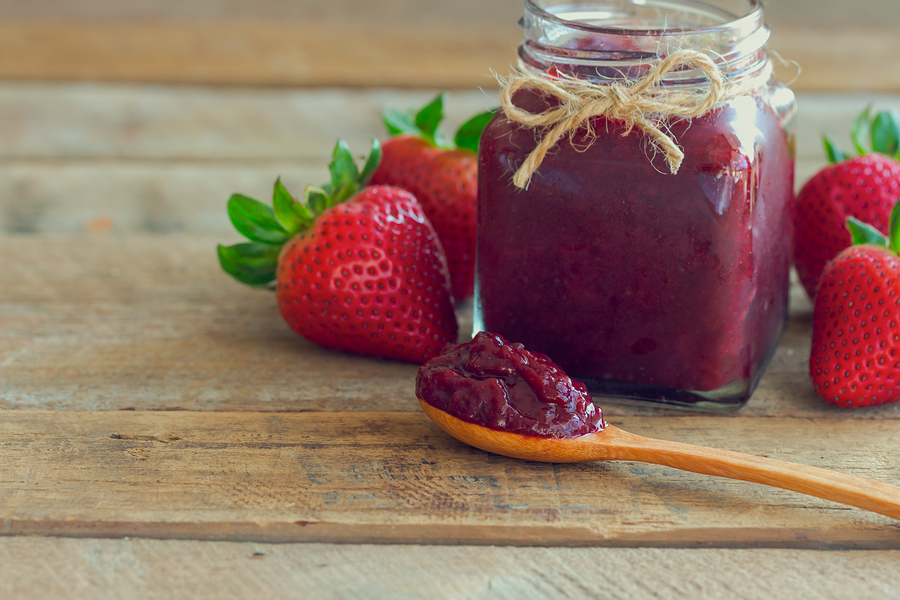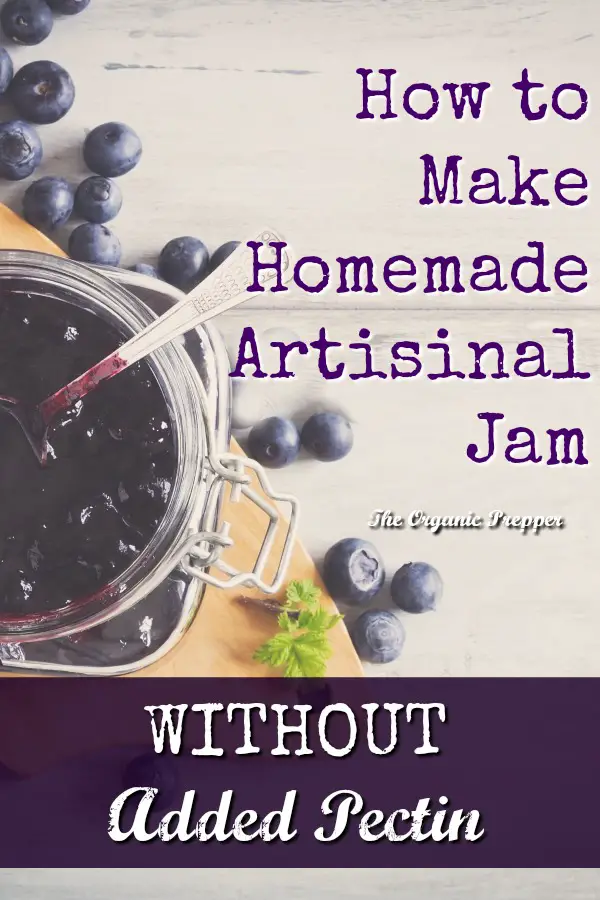Nothing is more of a summer tradition here at our house than making enough homemade jam from fresh fruit to see us through the winter. Get some fruit, some sugar, and a box of pectin and you’re good to go, right? Not so fast! You can actually make jam without pectin if you use my favorite old-fashioned method of thickening your product.
Why You Might Want to Make Your Jam WITHOUT Pectin
As the name of this website implies, we like to keep things nourishing and natural. A while back, I spent some time reading up on store-bought pectin and I was very unhappy to discover the jams I had been making for my family have been tainted with GMOs. I had unknowingly been contaminating the carefully sourced fruit and pricey turbinado sugar with the very things I strive to avoid, and I hadn’t even given it a second thought.
RELATED ARTICLE:
Most brands exclaim breathlessly, “All natural pectin” or “Made from real fruit”. And this is true – it does originate from fruit. Sound okay, right? Don’t be deceived. This misleading label makes it sound as though this is nothing more than some powdered fruit.
Here’s the label from the Ball pectin that was lurking in my pantry.
Storebought pectin contains additives that are most likely genetically modified. Dextrose is generally made from corn products (GMOs that are absolutely SOAKED in glyphosate). It is made from cornstarch, the main ingredient in good old High Fructose Corn Syrup.
RELATED ARTICLE:
Don’t let anyone tell you that citric acid is “just Vitamin C”. It is derived from GMO mold.
Not only does store-bought pectin contain unsavory ingredients, but it is also very highly processed. According to Wikipedia, this is how it is produced:
The main raw materials for pectin production are dried citrus peel or apple pomace, both by-products of juice production. Pomace from sugar beet is also used to a small extent.
From these materials, pectin is extracted by adding hot dilute acid at pH-values from 1.5 – 3.5. During several hours of extraction, the protopectin loses some of its branching and chain length and goes into solution. After filtering, the extract is concentrated in vacuum and the pectin then precipitated by adding ethanol or isopropanol. An old technique of precipitating pectin with aluminium salts is no longer used (apart from alcohols and polyvalent cations, pectin also precipitates with proteins and detergents).
Alcohol-precipitated pectin is then separated, washed and dried. Treating the initial pectin with dilute acid leads to low-esterified pectins. When this process includes ammonium hydroxide, amidated pectins are obtained. After drying and milling, pectin is usually standardised with sugar and sometimes calcium salts or organic acids to have optimum performance in a particular application. (source)
So, if you want to avoid GMOs and processed foods, what’s a homemade-jam making mama to do?
Jam has been around for thousands of years. The first known book of jam recipes was written in Rome in the 1st century (source). Since, I’m pretty sure our ancestors didn’t have those handy little boxes of Sure-Jell or RealFruit or Certo sitting in their pantries, I set out to learn how they made a thick delicious preserve to spread on their biscuits.
My first attempt at breaking up with the box was to make my own pectin with green apples. While I ended up with a tasty product, it wasn’t really jam-like. It’s possible, considering the time of year, that the apples were too ripe to allow this to work for me. You can find instructions on how to make your own pectin from apples HERE.
I continued to read recipes and methods from days gone by. It soon became clear that adding pectin wasn’t really necessary at all. In days past, the sugar and the fruit worked hand-in-hand to create the desired consistency. If you are determined to use pectin (some fancier jams are nicer with a thicker set-up) I strongly recommend Pomona’s Universal Pectin, a non-GMO, non-toxic pectin. Don’t be put off by the higher price – you can get several batches of jam from one packet of pectin, so it works out to a similar cost as the yucky stuff.
RELATED ARTICLE:
I combined bits from a few different methods and finally came up with a jam that the entire family was happy with. In comparison with the boxed pectin jam, it doesn’t gel quite as much, but after trying this jam, the texture of the other now seems slightly artificial to me. This produces an artisanal jam, a softer preserve with an incredibly intense fruit flavor. When using this method, you don’t get that layer of foam that you have to skim off the top like you do with the boxed pectin method. And best of all, you get two products for the price of one. You’ll have an additional sweet juice or syrup at the end of your process.
How to Make Jam without Pectin
First of all, I want to encourage you not to be deterred by the lengthy amount of time to make this jam. Very little of that time is spent hands-on. Nearly all of it is draining time. You’ll end up cooking your fruit down for far less time than the standard pectin-included method, and your fruit will taste fruitier because it’s so concentrated. Give it a try! You’ll be hooked!
- 7 pounds of fresh or frozen fruit (approximately 14-20 cups)
- ¼ cup of lemon or lime juice
- 3-5 cups + 2 tbsp of sugar (I’ve varied this and have even used no sugar at all, but this seems to be the happy place for my family’s preferences)
- A piece of clean, non-linty cotton fabric for draining (I used a flour sack towel. This will be permanently stained, so don’t use something you want to keep pretty.)
Directions:
- Prepare your fruit. For berries, this means washing them and sorting them, removing little leaves and twigs, as well as berries that are shriveled. For fruits like apples or peaches, this might mean blanching and peeling them, then removing the cores. Leave the odd green bit of fruit in, because less ripe fruit has more naturally occurring pectin than ripe fruit.
- Mash, finely chop, or puree your fruit. I used a blender to puree half of the fruit, and a food processor to finely chop the other half. We prefer a rough puree texture.
- Pour this into a large crock or non-reactive bowl, layering your fruit with half of the sugar. I use the ceramic insert from my crock-pot for this.
- Leave the fruit and sugar mixture in your refrigerator overnight. The juice from the fruit will combine with the sugar and form a slightly gelled texture. Some liquid will separate from the sugar and fruit.
- The next day, line a colander with a flour sack towel. Place the colander into a pot to catch the liquid from the fruit and sugar mixture. Pour your fruit and sugar mixture into the fabric-lined colander. Put this back in the refrigerator for at least an hour to drain. You can let it drain for longer with no ill effect – in fact this will result in an even thicker jam.
From this point on, you’ll be making two separate products: jam and fruit syrup.
- When you’re ready to make jam, scoop the fruit out of the fabric-lined colander and place it in a pot with lots of open area to help it cook down faster. (This gives more space for the liquid to evaporate.)
- The liquid that you caught in the other pot is the basis for your fruit syrup. You’ll have about 1-2 pints of liquid. Place that on the stove and bring it to a rolling boil. Add 1/4 cup of sugar and a tbsp of lemon juice per pint and reduce heat to a simmer. I like to add one big spoonful of jam to this to add a little texture to the syrup.
- Meanwhile, on another burner, add lemon juice and bring your fruit and sugar mixture to a simmer, stirring frequently. After about an hour, the texture will have thickened. If you still have a great deal of liquid, you can use a fabric lined sieve to strain some more out. (You can add this liquid to the syrup.)
- Fill sanitized jars with your products (syrup or jam). Process the jam in a water bath canner, according to the type of fruit you are canning and making adjustments for your altitude. Refer to the chart below for processing times.
And there you have it…it’s easy to make an intensely fruity artisanal jam without pectin!
Universal Jam Making Chart
The processing times are based on sea level. Adjust these times based on your altitude.
| FRUIT | SPECIAL INSTRUCTIONS | PROCESSING TIME |
| Apricot | Peel, slice in half to pit | 5 minutes |
| Blackberry | optional step: mill to remove seeds | 10 minutes |
| Blueberry | optional step: puree | 7 minutes |
| Cherry | Pit with a cherry pitter, chop before cooking | 10 minutes |
| Grape | Mill to remove seeds | 10 minutes |
| Huckleberry | Check for stems | 10 minutes |
| Peach | Peel, slice in half to remove pits | 10 minutes |
| Plum | Slice in half to remove pits | 5 minutes |
| Raspberry | Crush with a potato masher | 10 minutes |
| Strawberry | Remove cores, mash with a potato masher | 10 minutes |














